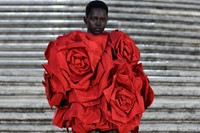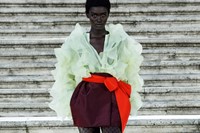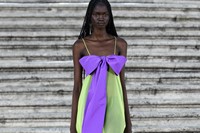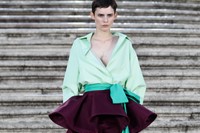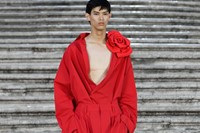On Friday, Valentino took over a fairly hefty chunk of Rome to stage an Autumn/Winter 2022 couture show that seemed to sweep through the whole city for inspiration and scoop up half its occupants as the audience. Windows were flung open on the Piazza di Spagna, Romans leaning out for a bird-eye view of the proceedings as a flow of figures streamed down the travertine marble staircases of the Spanish steps in the lingering sunset. Valentino’s Pierpaolo Piccioli had invited them all, plastering the city with posters asking them to come and see his latest wares – in Carravaggio colours, with fabrics sculpted like Bernini busts.
That’s the thing about Rome – the references are ceaselessly rich, the vistas spectacular, the inspirations boundless. Piccioli is a quintessentially Roman designer, honestly – he’s never afraid of a grand gesture, “the extravaganza of couture,” as he often terms it. And Valentino, of course, is part of the heritage of Rome itself: more than any other house, it encapsulates and celebrates the Alta Moda, Rome’s counterpart to the Parisian haute couture which, last century, offered serious competition to the fashion capital. A few practitioners still remain – but Valentino is the boss.
This collection demonstrated exactly why. It was a simultaneous paean to history and to the future, to the designer’s eye and the atelier’s hand – which, generally, exist in splendid isolation in the couture. Piccioli is a rare breed in that he can stun with technique while also impressing with inspiration – it’s not about counting ruffles, or cooing over precision stitching, or enumerating the hours of craft taken to make a dress, although all are evident. And it isn’t about resurrecting history – although, often, Piccioli manages to do that, conjuring up the golden age when couture was king in the mid-century, ringing in the changes and influencing fashion at every level. Piccioli’s couture does that, you see. But his aim is simultaneously simpler, and more lofty. He just wants to take your breath away.
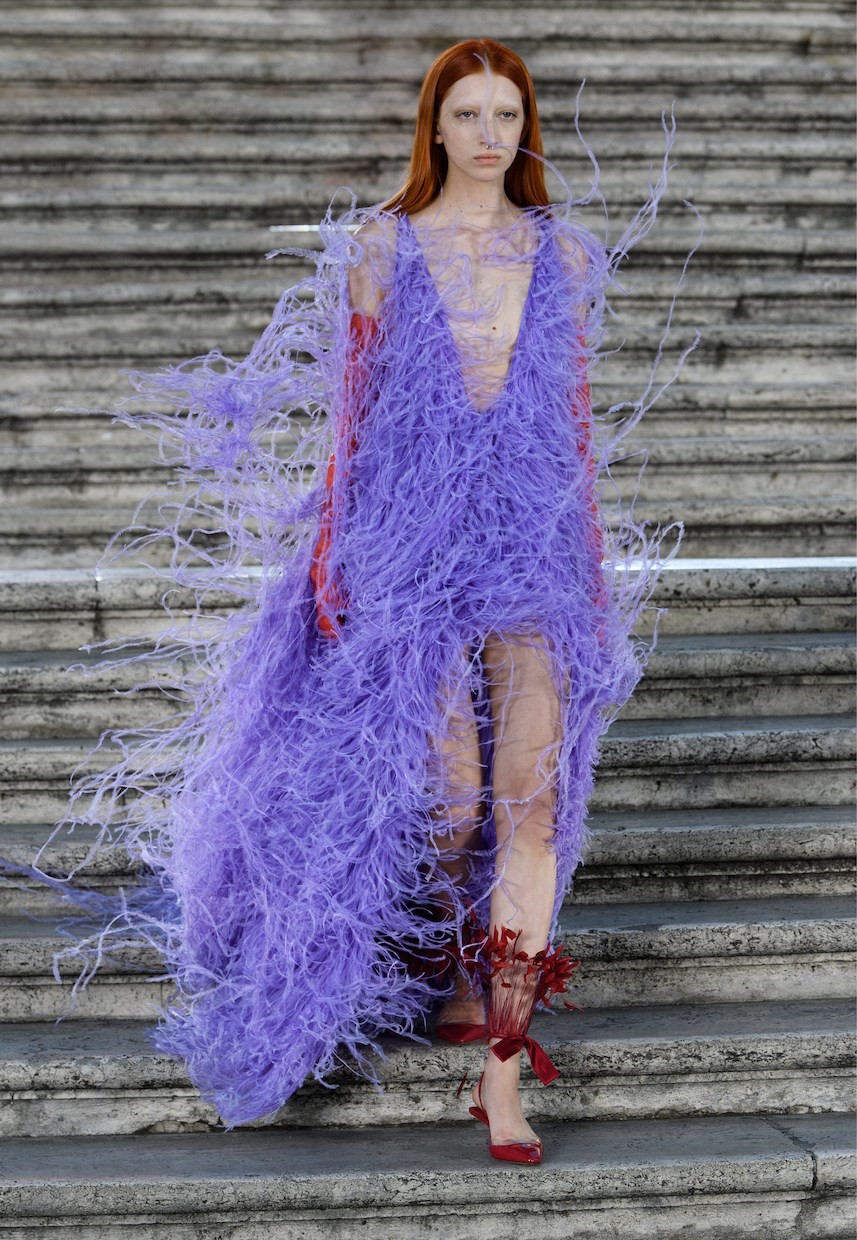
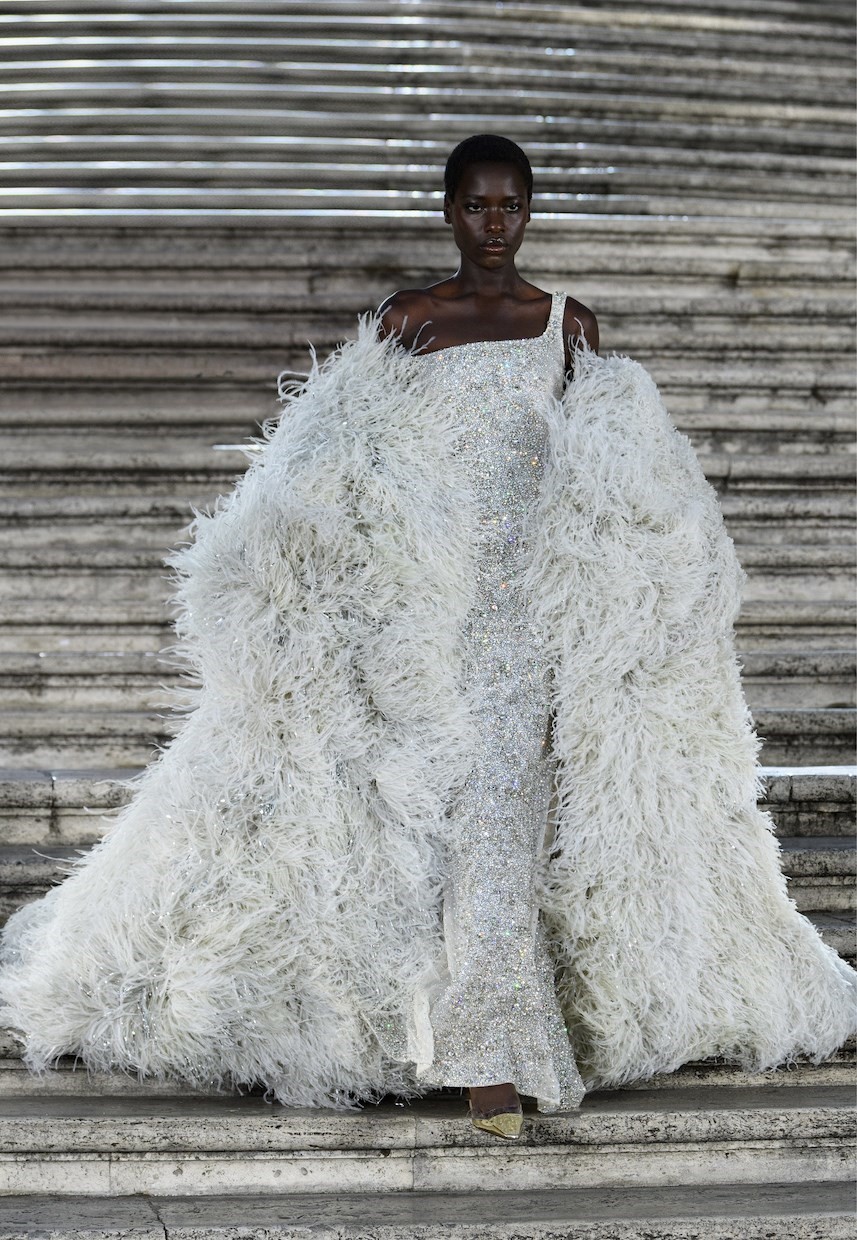
The Valentino show did just that. Your breath was bated, first of all, as the models began their descent: there’s 135 steps to navigate, in ball gowns and headpieces and rich trappings that summoned imagery of renaissance grandees in high pageantry. And, indeed, this was like a series of fabulous portraits come to life, with its focus on singularity and uniqueness rather than narrative thread. How to relate a fluoro orange hooded cape with an aureole of feathers around the face, to a sweet red chiffon dress with rose petals clustered across the breast, to a menswear look of spearmint trousers, tugged-out white tank top and a great trailing mass of claret silk bubbled into an evening jacket? There’s something that unites them in their joyous use of colour, for sure – one of Piccioli’s signatures, certainly a strength. But otherwise they are connected only in their disparity, as individual as the figures who wore them.
Couture is always about individuality, you could say – by its very nature every garment is crafted as a pure one-off, not so much engineered to a client’s specifications and body as entirely born from them. Yet Piccioli has pointedly championed this notion across his collections, especially over the past 12 months – last July in Venice it was a show dedicated to the individual styles of a bevvy of artists, this January a celebration of an array of different body types beyond the traditionally rail-thin models of the couture cabine. Those two approaches perhaps fused in this latest collection, which was also something of an homage to Piccioli’s 23 years at Valentino, spanning his own style and embracing that of its founder Valentino Garavani. “A personal story,” is how Piccioli described it. “The conversation with Valentino, how much of him is in me and how much I returned.” It was reflective and reflexive, and also refractive – ideas of Valentino’s past bounced through Piccioli’s particular perspective, to come up with something new. And so a bouncy dance dress with a skirt whirled into roses that Valentino created in 1959 – the first example of the famous Valentino red, incidentally – inspired the opening look, a bubble of gargantuan silk flowers that seemed to gobble up the body of the model bar two slender legs. Stems, as they called them back in 1959.
It was a gorgeous display, masterly in its display of finery – but it also connected deeper. Piccioli’s Valentino shows celebrate models of every shape, nationality and gender description. It is a diverse description of beauty that descended the steps, a vision of an all-embracing present that Piccioli said was the real power of his work. The ability to bring these people together, in that place, and project that image. “I have to be a witness to my time,” he stated. With shows like this, he’s helping to fashion them – and his vision is much wider than the clothes.

